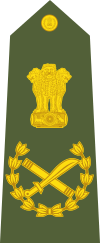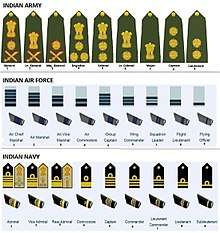Army ranks and insignia of India
| Military Manpower | |
|---|---|
| Active troops | 1,395,100 (2nd) |
| Reserve forces | 2,142,800 (7th) |
| Paramilitary forces and CAPF |
1,403,700 (1st) |
| Components | |
| Indian Army | |
| Indian Air Force | |
| Indian Navy | |
| Paramilitary forces of India | |
| Central Armed Police Forces | |
| Strategic Nuclear Command | |
| History | |
| Military history of India | |
| Ranks | |
| Air Force ranks and insignia | |
| Army ranks and insignia | |
| Naval ranks and insignia | |
The following tables present the ranks of the Indian Army. These ranks generally correspond with those of Western militaries, and in particular reflect those of the British and Commonwealth armies. Traditional names for ranks are still used, as well as Western names.
History
Until 26 January 1950, when India became a republic, the Indian Army utilised the British-pattern rank badges of the British Indian Army. Upon independence in 1947, India became a dominion within the British Commonwealth of Nations, but the old rank insignia, incorporating the Tudor Crown and four-pointed Bath Star ("pip"), was retained, as George VI remained Commander-in-Chief of the Indian Armed Forces. After 26 January 1950, when India became a republic, the President of India became Commander-in-Chief, and the Ashoka Lion replaced the crown, with a five-pointed star being substituted for the "pip."[1]
Field marshal
India has a field marshal rank, but it is mostly ceremonial. There are no field marshals in the army organizational structure at present and it has been conferred on only two officers in the past, the late Field Marshal Sam Manekshaw and the late Field Marshal K M Cariappa.
Field marshals hold their rank for life, and are considered to be serving officers until their death. Unlike other officers, they do not draw a pension. A field marshal gets the full pay of a general equal to the Chief of the Army Staff. He wears full uniform on all official occasions and runs an office in army headquarters. He also has a dedicated secretariat of his own.
Ranks and insignia
Current ranks
- Officers
| Equivalent NATO code | OF-10 | OF-9 | OF-8 | OF-7 | OF-6 | OF-5 | OF-4 | OF-3 | OF-2 | OF-1 | OF(D) and student officer | |||||||||||||||||||||||||
|---|---|---|---|---|---|---|---|---|---|---|---|---|---|---|---|---|---|---|---|---|---|---|---|---|---|---|---|---|---|---|---|---|---|---|---|---|
(Edit) |
 |
 |
 |
 |
 |
 |
 |
 |
 |
 | ||||||||||||||||||||||||||
| Field Marshal |
General | Lieutenant General |
Major General |
Brigadier | Colonel | Lieutenant Colonel |
Major | Captain | Lieutenant | |||||||||||||||||||||||||||
- Other ranks
| Equivalent NATO Code | OR-9 | OR-8 | OR-7 | OR-6 | OR-5 | OR-4 | OR-3 | OR-2 | OR-1 | |||||||||||||||||||||||||||
|---|---|---|---|---|---|---|---|---|---|---|---|---|---|---|---|---|---|---|---|---|---|---|---|---|---|---|---|---|---|---|---|---|---|---|---|---|
(Edit) |
 |
 |
 |
 |
No equivalent | No insignia | ||||||||||||||||||||||||||||||
| Subedar-major | Subedar | Naib Subedar | Havildar | Naik | Lance naik | Sepoy | ||||||||||||||||||||||||||||||
- Risaldar Major in cavalry and armoured regiments
- Risaldar in cavalry and armoured regiments
- Naib Risaldar in cavalry and armoured regiments. Called Jemadar until 1965.
Ranks that are no longer in use
The rank of Second Lieutenant is no longer in use; all new officers are commissioned as Lieutenants.
The appointments of Regimental Quartermaster Havildar and Regimental Havildar Major are no longer used in the Indian Army and those duties are now performed by JCOs.[2][3][4]
| Officers | Non-commissioned officers | ||||||
|---|---|---|---|---|---|---|---|
| Shoulder Insignia |
Arm |  |
 |
 |
 | ||
| Rank | Second Lieutenant |
Regimental Havildar Major |
Regimental Quartermaster Havildar |
Company Havildar Major |
Company Quartermaster Havildar | ||
Notable holders include Second Lieutenant Arun Khetarpal, Second Lieutenant Rama Raghoba Rane and Company Quartermaster Havildar Abdul Hamid.
Rank descriptions
- Indian Army Ranks can be classified into three categories.
Commissioned officers

Commissioned officers are the leaders of the army and command anywhere from Platoon, Company, Battalion, Brigade, Division, Corps & the Whole army.
Indian Army officers are continually put through different courses & assessed on merit throughout their career, for promotions and appointments. Substantive promotions up to Lieutenant Colonel or equivalent (subject to clearance of Part B and Part D exam for Major and Lieutenant Colonel) [7][8] and are based on time in service whereas those for Colonel and above are based on selection, with promotion to Colonel also based on time served. Due to steep hierarchy and few vacancies, most of the officers retire at the rank of Colonel and only a few make it to the rank of Brigadier and above.[9][10][11] Civilian equivalents are in accordance with government policies on functional allocation of duties in staff billets, otherwise the rank structure of the armed forces is different from the civilian with regard to years of service and vacancies available.
Indian Army officers undergo various courses such as Young Officers Course, Junior Command Course, Defence Services Staff College course at DSSC Wellington, Management Development Programme: Senior Defence Management Course, Higher Defence Management Course at the College of Defence Management (Secunderabad), Higher Command Courses, NDC courses at various premier institutions of Armed Forces for promotions. The same is applicable to officers other two services namely Indian Navy and Indian Air Force
Dress insignia are in Gold/Black/Silver based on regiments of the officers commissioned
| Ranks | Insignia | Notes[12][13] | Retirement age |
|---|---|---|---|
| Field marshal | National emblem over a crossed baton and sabre in a lotus blossom wreath. | Only two appointments have ever been made. | Not applicable. Life Long |
| General | National emblem over a five-pointed star, all over a crossed baton and sabre. | Held only by the Chief of Army Staff of the Indian Army. equivalent to Cabinet Secretary of India
Pay Level 18 Rs. 2,50,000 |
3 years as COAS or at the age of 62, whichever is earlier. |
| Lieutenant General | National emblem over crossed baton and sabre. | By selection.
36 years of commissioned service required. Lieutenant generals appointed as Vice Chief of Army Staff/Army Commanders/Equivalent/NFSG at Pay Level 17, Rs.2,25,000 HAG + Scale: Admissible to 1/3rd of total strength of Lt Generals Pay Level 16, Rs.2,05,400 - 2,24,400 HAG Scale: Pay Level 15, Rs. 1,82,200 - 2,24,100 |
60 |
| Major General | Five-pointed star over crossed baton and sabre. | By selection.
32 years of commissioned service required. Pay Level 14, Rs. 1,44,200 - 2,18,200 |
58 |
| Brigadier | National emblem over three five-pointed stars in a triangular formation. | By selection.
25 years of commissioned service required. Pay Level 13A, Rs.1,39,600 - 2,17,600 |
56 |
| Colonel | National emblem over two five-pointed stars | Colonel & above are Selection Grade.
15 years of commissioned service required for selection. Duration of Time Scale promotion to Colonel is 26 years of commissioned service. Pay Level 13, Rs. 1,30,600 - 2,15,900 |
54 |
| Lieutenant Colonel | National emblem over five-pointed star. | on completion of 13 years reckonable commissioned service subject to clearance of Part D exam.
Pay Level 12A, Rs. 1,21,200 -2,12,400 |
NA |
| Major | National emblem. | on completion of 6 years reckonable commissioned service subject to clearance of Part B exam.
Pay Level 11, Rs. 69,400 - 2,07,200 |
NA |
| Captain | Three five-pointed stars. | on completion of 2 years reckonable commissioned service.
Pay Level 10B, Rs. 61,300 - 1,93,900 |
NA |
| Lieutenant | Two five-pointed stars. | on commissioning into Indian Army as an Officer in Pay Level 10
Rs. 56,100 - 1,77,500 |
NA |
Junior commissioned officers
Junior commissioned officers are commissioned as officers from the ranks and are broadly equivalent to warrant officers in Western armies.
| Ranks | Insignia | Retirement Age | |
|---|---|---|---|
| Infantry and other arms | Cavalry and armour | ||
| Subedar major | Risaldar major | Gold national emblem with stripe | After 34 years service or at the age of 54, whichever is sooner. |
| Subedar | Risaldar | Two gold stars with stripe | After 30 years service or at the age of 52, whichever is sooner. |
| Naib subedar | Naib risaldar | One gold star with stripe | After 28 years service or at the age of 52, whichever is sooner. |
Other ranks
Other ranks in the Indian Army include Non Commissioned Officers ("NCOs") and Soldiers ("sepoys" or "jawans")
Non commissioned officers
Non Commissioned Officers ("NCOs") are soldiers promoted to positions of responsibility, and are equivalent to junior non-commissioned officers (sergeants and corporals) in Western armies.
| Ranks | Insignia | Retirement Age | |
|---|---|---|---|
| Infantry and other arms | Cavalry and armour | ||
| Havildar | Daffadar | Three rank chevrons | After 26 years service or at the age of 49, whichever is sooner. |
| Naik | Lance daffadar | Two rank chevrons | After 24 years service or at the age of 49, whichever is sooner. |
| Lance Naik | Acting lance daffadar | Single rank chevron | After 22 years service or at the age of 48, whichever is sooner. |
Soldiers
| Ranks | Insignia | Retirement Age | |
|---|---|---|---|
| Infantry and other arms | Cavalry and armour | ||
| Sepoy | Sowar | Plain shoulder badge only | After 19 years service or at the age of 42, whichever is sooner. |
Retired officers: form of address
On 21 July 2014, the Indian Army issued a circular for retired personnel informing them that the correct form of addressing a retired officer is "Brigadier ABC (Retd) and not Brigadier (Retd) ABC".[14] The reason for this was stated as being, "Rank never retires, it is an officer who retires."[14]
See also
References
- ↑ "New Designs of Crests and Badges in the Services" (PDF). Press Information Bureau of India - Archive.
- ↑ Personnel Services Directorate. "Psdte311212" (PDF). Retrieved 4 December 2015.
- ↑ "DSR Volume I, Chapter IV—JCOs, WOs,OR AND NON-COMBATANTS (ENROLLED)". Indian Army. 2014. Archived from the original on 9 November 2014. Retrieved 4 December 2015.
- ↑ Kumar, M. K. Sunil (16 May 2012). "Rules of the Raj hindering havildars' promotion". The New Indian Express. Retrieved 3 August 2015.
- ↑ Singh, Navdeep. "Clarification on the nature of 'Group-A' services". India Military Info. India Military Info. Retrieved 22 February 2018.
- ↑ India, Times of. "JCOs are Gazetted". ToI. Times of India.
- ↑ Times, Hindustan. "Army defers key annual promotion exam amid LoC tensions". Hindustan Times. Hindustan Times. Retrieved 22 February 2018.
- ↑ India, USI. "PROSPECTUS". USI. USI of India. Retrieved 22 February 2018.
- ↑ Government of India (4 November 2008). "MoD Letter No. 1/55/2008 D(Pay/Services)—Terms and Conditions of Service" (PDF). Indian Army. Government of India, Ministry of Defence. Retrieved 4 December 2015.
- ↑ Tirkey, Ajay (30 August 2008). "Ministry of Defence Resolution—Sixth Central Pay Commission" (PDF). The Gazette of India. Retrieved 4 December 2015.
- ↑ "NCC Spl entry Scheme" (PDF). joinindianarmy.nic.in. Indian Army. Retrieved 13 September 2015.
- ↑ "Army Pay Rules" (PDF). MoD. GoI. MoD. Retrieved 21 February 2018.
- ↑ Army, Indian. "NCC SPL ENTRY NOTIFCATION" (PDF). Indian Army Offl website. Indian Army. Retrieved 22 February 2018.
- 1 2 Sura, Ajay (3 August 2014). "Rank never retires, officer does: Army". The Times of India. TNN. Retrieved 13 September 2015.